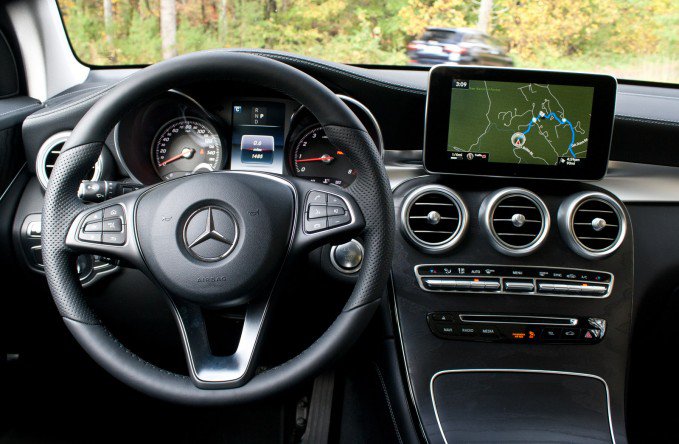Mercedes-Benz is in the middle of a huge product offensive with each model getting a complete makeover, and now the biggest moneymaking SUV for the German automaker has emerged from its time under the scalpel.
The GLC replaces the GLK as the brand’s compact crossover, and the new “C” in the naming structure means that it shares a platform with the C-Class. Even though the GLK first came out in 2009 in the thick of the economic recession, sales have always been strong, so the GLC has a lot riding on it. This redesign has to be successful, and luckily, Mercedes has another winner in its lineup.
New Mainstream Look
One of my favorite things about the GLK was its boxy style; it helped the CUV stand out in a market full of bubbly, jellybean-like crossovers. The GLC gets a more rounded out look that’s more in tune with the rest of the lineup and more mainstream in general. More attractive than the BMW X3 and Audi Q5 it competes against, the GLC’s stance is assertive and luxurious, so it still stands out, even without the signature boxy look.
The GLC has a clean, muscular design devoid of any tacky bulges or unnecessary lines that make it look over the top or just plain ugly (hello, GLE Coupe). Its best angle is from the front, where the strong double-deck front grille dominates the SUV’s look with a massive Mercedes star that’s almost the size of my face. From all other angles, it blends in with other SUVs a bit too much, but mainstream looks are what sells, so this isn’t really a criticism.
High-End Interior
I drove the higher-end GLE Coupe recently, and the GLC’s interior is far superior. It feels just as luxurious has a car that costs nearly $30,000 more and has a better dashboard layout to boot. Even more, it has a lot of the same driver assistance and safety features available as its more expensive sibling, so equipped with Distronic Plus, it can practically drive itself.
Inside, barely any NVH makes it into the cabin, and everything feels velvety smooth. The mix of textures and materials used is classy and comfortable. I love the clean waterfall dashboard layout; not having a center console-mounded gear selector really cleans up the layout and makes more room for useful storage cubbies. The downside of the stalk gear selector behind the steering wheel is that it will drive you crazy until you stop mistaking it for the windshield wipers.
The infotainment system is operated by a clickable touchpad and a rotary scroll wheel. Mercedes refuses to do touchscreens, which would make the system more user-friendly, but it is getting better with the touchpad being able to understand smartphone gestures like swiping and pinching. As it is now, the menu structure and buttons aren’t very intuitive, and requires a lot of playing around before you get used to it.
ALSO SEE: 10 Things I Learned Driving the 2016 Mercedes-Benz GLE Coupe
More importantly, the redesign makes the GLC bigger and more roomy than the GLK without adding on any extra pounds — it actually weighs 170 pounds lighter than the outgoing model. This means all passengers are treated to more head, shoulder and leg room. Cargo capacity has also increased to 20.6 cubic feet, and the rear seats can fold down with the touch of a button and put back into place with one hand. With the 40/20/40 seats folded down, 56.5 cu. ft. of cargo can be swallowed (pretty similar to what the X3 and Q5 offer).
The Drive
Automakers use the word “sporty” and “dynamic” to describe their SUVs more often than Kanye West compliments himself or Kim Kardashian takes a selfie. More often than not, the “sporty” descriptor is a huge overstatement, with the cars never really living up to the automaker’s claims.
The different driving modes make a big difference in the GLC’s personality, and in the right modes, “sporty” can be a legit descriptor.
In Eco or Comfort mode, the GLC is very restrained and doesn’t drive any differently from an Acura or Kia, but in Sport or Sport+ mode, the GLC’s personality changes and it feels legitimately sporty, like a Mercedes should. Everything gets tighter and more responsive.
Behind the wheel of the GLC, the connection with the C-Class is immediately obvious. The GLC drives exactly like it should, meaning the best way to describe its driving dynamics is that it behaves like a jacked-up C-Class.
The increased ground clearance and weight mean that the GLC will never have the same steering feel or responsiveness as the C-Class, but the rest of the sedan’s dynamics carry through to the SUV.
Driven through the winding country roads just outside of Atlanta, Georgia (where Benz’s new U.S. headquarters is located), the GLC remained miraculously flat, with barely any body roll making itself known in Sport and Sport+ mode. It inspires a surprising amount of confidence when driven through twisting roads.
Powered by a 2.0-liter biturbo four-cylinder, the GLC 300 puts out 241 horsepower and 273 pound-feet of torque. Power makes it to all four wheels with a 45/55 front to rear split via a pretty seamless nine-speed transmission. Because the SUV is lighter than it used to be, it feels faster than its numbers would suggest.
The Verdict: 2016 Mercedes-Benz GLC 300 Review
I drove the European-spec GLC 250 a few months ago and while I was impressed with the new design and the high-end interior, I concluded that the drive was somewhat uninspired and it was geared more toward comfort than sport. The 300 model rectifies this, so you get the best of both worlds. The extra horsepower and torque make a big difference in how the SUV feels, and if you want it to be, the GLC feels plenty sporty.
The GLC is a great crossover and will continue to see strong sales, just like the boxy GLK that came before it. The best thing about the GLC 300 is that unless you really need the extra space and utility, I see no reason why you’d need to spend more money on a GLE, because the GLC has more luxury and features than you’d ever want, and it feels more nimble and sporty than the GLE ever could.
Discuss this story on our Mercedes GLC Forum













